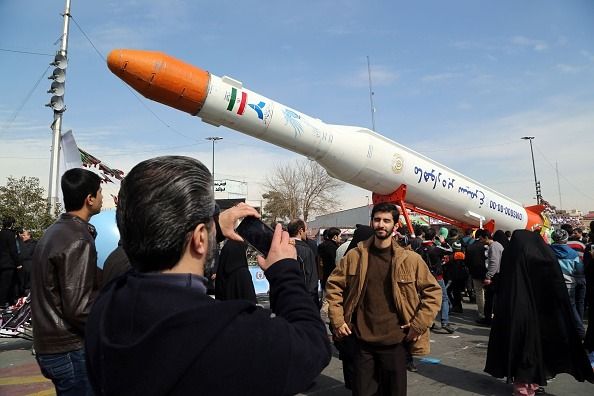Why Iran is launching a rocket
By Ariane Tabatabai | February 25, 2016

Iran is hoping to launch a rocket next week. This is significant in and of itself, and also a good indicator of the Iranian security establishment’s thinking now that the Joint Comprehensive Plan of Action (JCPOA), the international agreement limiting Tehran’s nuclear activities, has gone into effect. It is also an example of the kind of challenges that lie ahead for the United States and other foreign powers dealing with Iran.
Tehran is preparing to launch a two-stage Simorgh rocket, or space launch vehicle, with the goal of putting a satellite into orbit. The Simorgh is named after a mythological Persian bird representing wisdom and healing. In the past, the country has placed four satellites into low-altitude orbit, but none stayed aloft for more than a few weeks; other attempts failed altogether. The Simorgh space launch vehicle is more powerful than previously used models, giving Iran a shot at a successful launch. Tehran has also been developing its satellite technology, and while its designs are nowhere close to the world’s most sophisticated, it is making progress. If next week’s launch is successful, it will mark an advance for the country in both delivery and communications capabilities.
Careful timing. Iran issued a notice to airmen (or NOTAM) for March 1-2 closing the air space above the Imam Khomeini Space Center in Semnan province, east of Tehran, indicating that the launch will take place then. The event will inaugurate the Imam Khomeini Launch Pad, which the space center intends to use in the future to launch larger rockets.
The launch comes at an interesting time in Iranian politics. First, it takes place following the January implementation of the JCPOA. Having seen its nuclear activities limited by the agreement, Tehran feels compelled to assert power in other ways, including by undertaking cyber attacks, testing missiles, and, now, launching a rocket. These displays of power help satisfy the domestic factions who feel like the country made too many concessions, limited its nuclear program too much, and ultimately lost in the negotiations. They appease the hardliners, while allowing the moderates in power and their reformist supporters to continue implementing the nuclear deal and make progress on other items without substantial pushback.
Second, the launch is scheduled to take place (link in Persian) shortly after the 10-day annual period when Iran marks the anniversary of the 1979 Islamic Revolution. The weeks preceding and following this period generally provide a platform for Tehran to showcase its “achievements.” The Simorgh does that job: Members of the Iranian political and security establishments have been hyping (link in Persian) the Simorgh in the media, highlighting that it has a range of 500 kilometers, roughly twice that of older Iranian rockets, and a payload two or three times heavier.
Third, the Persian New Year, March 20, is right around the corner. For the regime, it’s crucial to make sure that when Iranians look back at the past year, they don’t just remember that Iran undid some key parts of its nuclear program under the JCPOA, but also that it stepped forward in other domains. Projecting power with a rocket allows the government to end the year on what it sees as a positive note.
Fourth, the launch, which seems to have initially been scheduled for February 23-24, a few days before parliamentary and Assembly of Expert elections, will now take place after voting. The official campaign cycle (which started around February 18 and ends with the February 26 elections) and the months of politicking that proceeded it have highlighted deep divisions within the country and the regime. The Simorgh, true to the symbolism of its name, is a good healer, allowing the government to end this period of disagreement and unify the political and security establishments (until the next big thing divides them again).
The rocket launch, like missile testing, serves another purpose, too: It helps the regime continue its narrative of self-sufficiency, independence, and progress on scientific, technological, and military fronts. This narrative allows Tehran to signal to adversaries that it’s a power to be reckoned with, while reassuring domestic audiences and rallying them around the flag. Since the early 2000s, the narrative has been framed around the nuclear program, which today remains the centerpiece of the Iranian revolutionary self-image. But Tehran also tries to highlight its mastery of various other technologies, and show it can develop them without help from the outside world, by underlining the progress it has made in the drone, cyber, missile, and space domains in addition to the nuclear fuel cycle.
To be sure, Iran bases many of its “own” designs on those developed by other countries, including the United States. It relies heavily on foreign technology, essentially taking parts from elsewhere and assembling them itself, stamping “Made in I.R. Iran” on the finished products. But the country’s obsession with self-reliance—which goes back to the rule of Reza Shah in the first half of the 20th century, and was revitalized by the isolation stemming from the Iran-Iraq War in the 1980s—remains a driving force behind Iran’s science-and-technology programs, and is still central to the story it tells itself.
Pushing the defense envelope. The planned rocket launch is further evidence of Iran’s determination to develop its space delivery vehicle capabilities. While the Simorgh is not a ballistic missile, it does represent a proliferation concern, given the level of overlap between space launch vehicles designed to put satellites into space and ballistic missile technology.
The launch also illustrates Tehran’s willingness to push the envelope in terms of weapons development without actually violating the terms of the JCPOA. In fact, such non-nuclear technological and defense activities are important to making sure that JCPOA implementation moves forward. That’s because the Iranian security establishment will more easily tolerate the concessions made under the JCPOA if it feels like it can boost its cyber, missile, and space capabilities.
Iran’s pursuit of these non-nuclear defense technologies presents a challenge to the United States, the other powers that negotiated the JCPOA with Iran, and the international community, because they require an adequate response that doesn’t jeopardize the deal’s implementation. It would be in no one’s interest to see the agreement derailed and Iran restart nuclear weapons development.
Managing Iranian mischief will require self-awareness in Washington, allowing it to see the limits of its own power so that it allocates resources to battles it can actually win. Washington also has to distinguish between actual violations of JCPOA terms and Iranian efforts to project power, which while not desirable, don’t jeopardize the deal or US national security. In other words, knowing which Iranian offenses are felonies and which are mere misdemeanors will allow the United States to make sound policies. Tehran is sure to continue to try to project power—possibly in more substantive ways than it has so far—and increase its capabilities in various operational domains. US leaders should remain vigilant and begin compiling a list of possible responses that wouldn’t directly or indirectly threaten the JCPOA.
Together, we make the world safer.
The Bulletin elevates expert voices above the noise. But as an independent nonprofit organization, our operations depend on the support of readers like you. Help us continue to deliver quality journalism that holds leaders accountable. Your support of our work at any level is important. In return, we promise our coverage will be understandable, influential, vigilant, solution-oriented, and fair-minded. Together we can make a difference.
Topics: Columnists, Nuclear Weapons, Technology and Security














